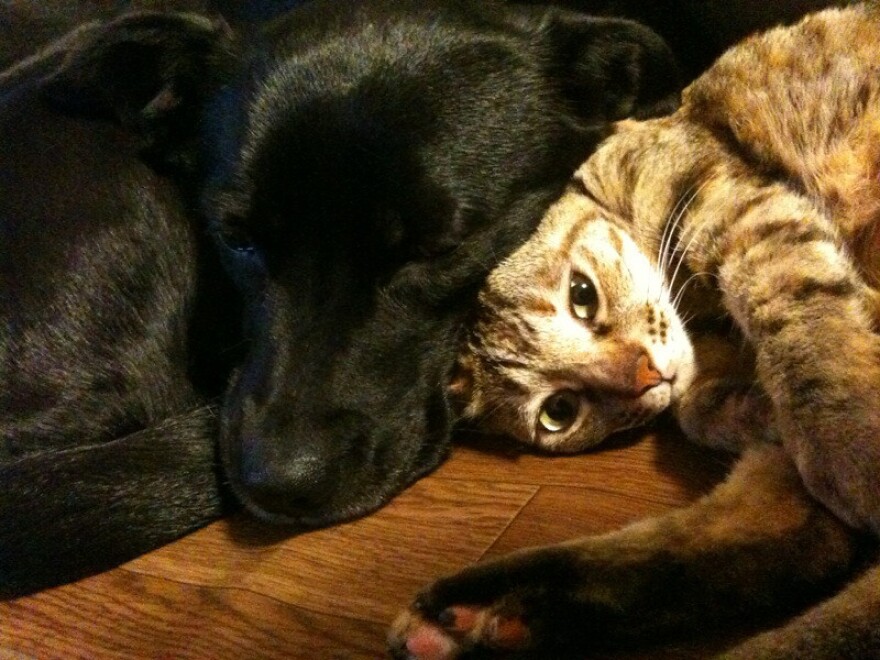Dr. Debra Horwitz, DVM, a St. Louis-based veterinary behaviorist and veterinarian joined St. Louis on the Air again on Tuesday to share her pet wisdom and answer listeners’ questions about their dogs and cats.
Here are some of the most pressing questions posed to Horwitz, of Veterinary Behavior Consultations, during the noon hour along with her answers.
Does tone matter when it comes to addressing dogs and cats?
“Tone of voice has a big impact when you’re trying to teach your dog a new cue or task like ‘sit,’” Horwitz said. “It is better to say it softer than louder, even though there’s this theory you have to dominate your dog and control them. In reality, they already know how to sit, we’re just trying to put it under verbal control. If you use a strong voice, a verbal reprimand, you will interrupt behavior. But interrupting behavior is not the same thing as a guaranteeing the behavior won’t happen again.”
My five-year-old has a puppy but the puppy bites back with a menacing bite. What should I do?
“Your five-year-old and the puppy need more supervision, so that if the puppy is overwhelmed or wants to be left alone, that is respected,” Horwitz said. “There are times when puppies play bite because that’s what they do with other dogs. That may be too rough, too hard for our skin, and when we push them away, they think that is play and come back. Some animals, when resting, don’t want to be bothered. In general, when a dog or cat is resting, it is better to approach and talk to them first, rather than just picking them up.”
Why do dogs start barking incessantly when they go outside? Is it separation anxiety?
“Not all dogs that bark are upset that they are separated from their humans,” Horwitz said. “If someone goes to work and leaves their dog outside and the dog barks incessantly and tries to get back in the house that dog might have separation anxiety. That can be diagnosed and treated by a veterinarian. Dogs often bark at something unfamiliar. If there are bikes going by, cars going by, other dogs, they might bark. If the owner isn’t home, they don’t know, so a polite letter or stop by the house might be helpful.”

Any way to stop cats from bringing home animals like mice or birds?
“You can keep them inside,” Horwitz said. “There’s also something called a cat bib, which doesn’t allow them to stalk and jump in the same way. I’ve also heard of a collar that alerts the bird. You need a really big bell on the collar, like a jingle bell, otherwise.”
At night, my cats become wild kitties and they meow and scratch. Is there any help for this?
“The normal ethology of a cat is that they are diurnal,” Horwitz said. “They are most active in the early morning and early evenings. I would vary when you feed them. It might help to feed them before you go to bed. Before you feed them, have an aerobic play session with them, something for them to do, because that is the active time of night.”
A friend of mine has two cats and one cat started a couple of years after he got him urinating and pooping everywhere. He’s tried multiple litter boxes, but we just can’t figure out what’s going on.
“Most often, when there are long-term litter box issues, it has something to do with the toileting area provided for the cat if there are no medical issues, no orthopedic issues,” Horwitz said. “The best toileting area for your cat has to do with the size of the box (does it fit the cat) and where the box is located. If you have two cats, you should have the number of cats, plus one. They need to be in different locations. Thirdly, what’s in the litter box matters. Some cats don’t like the litter material provided them or it isn’t clean enough for them.”
One of my cats has gotten overweight because he’s eaten all the food of two cats. How can we separate the food?
“Sometimes the cat that eats all the food only may have access to the food bowl at select times, so it eats as much as it can,” Horwitz said. “A cat can’t monopolize multiple food bowls. One cat can’t cover them all at the same time. Secondly, cats that are heavier are not good jumpers. Find a place to put the food bowl that is higher.”
Are there any factors specific to the St. Louis area that impact pets’ behavior?
“One thing that has a big influence is our thunderstorms. There’s a certain percentage of dogs that are noise sensitive. We can have thunderstorms day after day after day and dogs don’t have time to relax. If you see your dog has sensitivity, talk to your veterinarian about ways to make your dog more comfortable during a storm.”
St. Louis on the Air brings you the stories of St. Louis and the people who live, work and create in our region. St. Louis on the Air host Don Marsh and producers Mary Edwards, Alex Heuer and Kelly Moffitt give you the information you need to make informed decisions and stay in touch with our diverse and vibrant St. Louis region.






